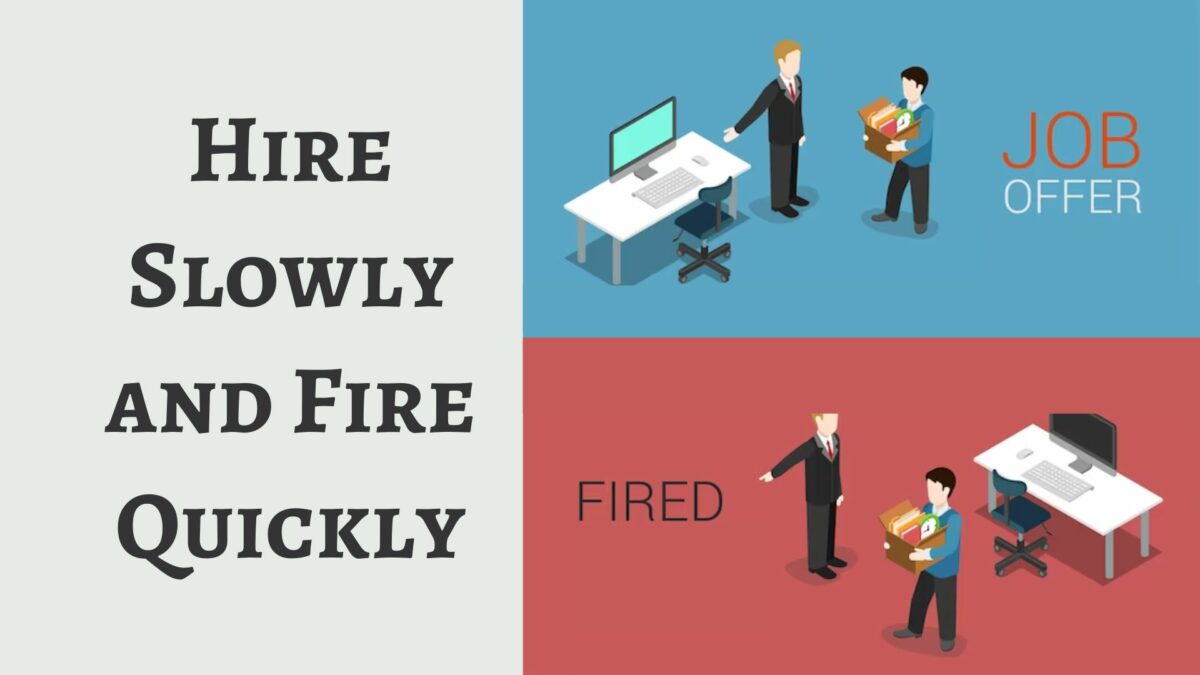“Be slow to hire and quick to fire.”
— Ben Taitelbaum

Despite my military background, I’d like to think of myself as a warm and fuzzy kind of guy. When I was in the Army, we came up with an acronym to describe such people: SNAGs – Sensitive, New Age Guys. During my Army days, I had to kick two people out of the military. It wasn’t difficult; they’d both violated clear, bright-line rules for which the consequence was getting kicked out. One had repeated drug offenses. He was a generally good kid but just got caught up doing the wrong thing. The other tried to assault one of my non-commissioned officers. Needless to say, I thoroughly relished taking him to jail and ensuring his stay there was long and miserable. Don’t screw with my guys.
Once I entered the civilian world, it was more difficult. I had to fire a few people along the way, and it was never a clear-cut case like it was in my Army times. All of them were good people, tried hard, and played by the rules. But, in each case, there was a clear mismatch between their talents and what we needed.
Still, in a couple of cases, I probably let situations linger for far longer than they needed to. There were several reasons:
- Had I issued clear enough guidance? I’m not exactly the most detail-oriented vision provider. When I managed, I’d describe end states and let people figure out how to get there. When I had team members who struggled with executing the vision, I’d switch to a more directive style of leadership. Still, if that didn’t work, I questioned myself. Was I a good enough leader? Was I a good enough manager? Leadership and management are two different skills, after all. I wanted to give people extra chances and extra chances because of my own internal concern that I’d not given them what they needed to succeed.
- There was rarely a clear-cut case of outright failure. In most cases, it was more of a gut feeling surrounding subpar performances. These people always had excuses and justifications for why something didn’t happen, and most of the justifications were reasonable. Again, the justifications and excuses caused me to question myself – was I not doing enough to remove obstacles to create the conditions for success?
- If you care about your team members, then it’s hard to let them go. These were people who were depending on me, in no small part, to help them put food on the table. I knew their families, and their situations, and genuinely liked these people. Sure, the maxim that letting someone go is simply giving them an opportunity to find work that they’re truly happy about and will succeed in, but it’s hard to override the emotions and the thinking that it’s your fault when it has to happen.
At one point, the company I’d co-founded had become bloated. We were on a large contract, projected out into the future–assuming that this contract would continue and would attract/spawn/magically produce more work–and hired accordingly. We were overstaffed. Fortunately, we never had to lay anyone off because we kept finding just enough short-term work to keep going while we were at our nadir, and there were a few people who left of their own accord to try different things. When fortunes turned and we started growing and needing more people again, we were hesitant to recreate the previous situation of having too many people on the payroll.
My co-founder was discussing this conundrum with another tech founder in the area when he heard the quotation I used to start the article.
With that mantra in mind, we redefined the conditions in which we’d bring on an additional permanent headcount onto our team.
- We would only hire someone when we had six months of payroll in reserves, including the new person’s overhead costs. That would ensure that, if the tides turned again, we’d not have to lay someone off as soon as we hired them. We always figured that if we couldn’t find more/new work within 3 months, something was terribly wrong, and we’d probably need to consider winding up anyway.
- We would only hire someone when we’d worked with that person as a contractor previously. Our ideal timeframe was six months of contracting work before making an offer, although sometimes, for exceptional people, we’d shorten it to three months. We needed to see proof in the pudding before we’d hire. People can interview exceptionally well and make their resumes look like they’re rock stars just waiting to be unearthed, but until they can put paid to the notion that they can deliver, we didn’t want to take chances. Working on a 1099 contractor basis gave us the freedom to evaluate a body of work before making a true commitment. We felt, emotionally, that we had less commitment to our 1099 contractors than to our employees, as most business owners should feel. Yes, we valued our vendor network and relationships, but if push came to shove, we were going to drop our contractors before we dropped our employees.
- We wanted to keep a contractor to employee ratio of somewhere between 2:1 and 3:1. We knew many, many more contractors than people we’d feel comfortable hiring (even if, in theory, we’d hire them all based on the levels of competency they displayed). A lot of them wanted to be contractors, so it worked out well. We felt that this ratio allowed us to invest disproportionately in our employees – hack days, conferences, training, etc. – while not putting our enterprise at risk for overcommitment.
- The people we hired had to be bought into the concept of joining a team. While we hired (and continue to hire) rock stars, none of them were solo artists. We’d rather take someone with 90% of the talent who’s a team player than a 100% talent who is purely an individualist.
When you’re an entrepreneur, once you start getting sales coming in the door, it’s tempting to hire help. I guess because people see other companies that have employees, they immediately default to the notion that they need employees in order to succeed. That’s simply not the case. There are other ways to acquire and retain talent without putting them on the payroll because once you put someone on the payroll, as a business owner, you take on a new level of responsibility in what you’re promising to that employee. I never took hiring lightly.
On the flip side, when an employee is not a good fit and clearly isn’t delivering to expectations, don’t delay the inevitable by putting them on performance plan after performance plan. Other employees have to pick up the slack of the underperformer, and they know what’s going on. It’s no mystery that the underperforming employee isn’t carrying the water, and the others will start to question why that person is still around and what’s being done to improve the situation. The underperforming employee is miserable. They walk around with a hatchet over their head the whole time, just waiting for it to fall. Morale and productivity decrease.
It’s possible to fire someone with dignity. I’m probably no expert, but here are a couple of things I tried to do:
- Only fire on a Friday. Yes, I know that some people say that Friday firings are inhumane, but I felt like Fridays before lunch were the best, as it gave the person some time to emotionally deal with the situation. Of course, if there was a performance plan, it ended on a Friday so that the date was no surprise.
- Give termination pay. Even if the person provided no value, I wanted to provide at least a couple of months of termination pay to ease the transition. Some small businesses may not have the cashflow to handle that, but that’s probably a sign that you shouldn’t be hiring in the first place.
- Help the person, if possible, find another job. Again, this may not always be possible, and the person may not want your help, but if it’s a situation where the person was a good performer, but just not the right fit (I can think of one instance where this was the case), then help the person find a new job. If the person finds a new job before the termination pay ends, keep giving the termination pay. You gave your word.
As a small business owner, cash flow is king. Yes, I am a master of clichés. If you maintain an unproductive employee, you’re sucking cash flow away from other, more productive uses. You have a greater responsibility than any one employee. You have a responsibility to your entire team. While it’s tough to avoid emotions in a firing decision, that’s exactly what you have to do – the rational calculation of whether or not incremental, additional investment in the person will turn that person around and get the performance you need. If not, you’re creating a liability, and additional liabilities do not a successful business make.
How have you dealt with hiring and firing as a business owner? Let’s talk about it in the comments below!
Author Profile
- John Davis is a nationally recognized expert on credit reporting, credit scoring, and identity theft. He has written four books about his expertise in the field and has been featured extensively in numerous media outlets such as The Wall Street Journal, The Washington Post, CNN, CBS News, CNBC, Fox Business, and many more. With over 20 years of experience helping consumers understand their credit and identity protection rights, John is passionate about empowering people to take control of their finances. He works with financial institutions to develop consumer-friendly policies that promote financial literacy and responsible borrowing habits.
Latest entries
 Low Income GrantsSeptember 25, 2023How to Get a Free Government Phone: A Step-by-Step Guide
Low Income GrantsSeptember 25, 2023How to Get a Free Government Phone: A Step-by-Step Guide Low Income GrantsSeptember 25, 2023Dental Charities That Help With Dental Costs
Low Income GrantsSeptember 25, 2023Dental Charities That Help With Dental Costs Low Income GrantsSeptember 25, 2023Low-Cost Hearing Aids for Seniors: A Comprehensive Guide
Low Income GrantsSeptember 25, 2023Low-Cost Hearing Aids for Seniors: A Comprehensive Guide Low Income GrantsSeptember 25, 2023Second Chance Apartments that Accept Evictions: A Comprehensive Guide
Low Income GrantsSeptember 25, 2023Second Chance Apartments that Accept Evictions: A Comprehensive Guide

